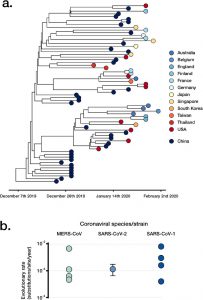The Lachlan Coin and Sebastian Duchene teams and collaborators in the Department of Microbiology and Immunology, University of Melbourne, Australia, provided the first direct RNA sequence of the SARS-CoV-2, detailed the mRNA structure of the subgenome length of this coronavirus, and described various aspects of coronavirus evolutionary genetics revealed from shared data. Relevant articles were released on March 7 on the preprint server bioRxiv.
SARS-CoV-2 is a positive single-stranded RNA virus of the family Coronaviridae that is associated with beta-coronaviruses that can infect mammalian and avian hosts, such as the MERS coronavirus and the SARS coronavirus.

To determine the structure of mRNAs of the subgenome length of SARS-CoV-2, researchers used a recently established direct RNA sequencing method based on highly parallel nanopore arrays. Briefly, nucleic acids were prepared from culture material with high levels of SARS-CoV-2 and sequenced on the GridION platform.
With this approach, the SARS-CoV-2 sample yielded 680,347 reads containing 860 Mb of sequence information in 40 hours of sequencing. Consistent with the genome of the cultured isolates of new coronavirus, partial reads belonged to coronavirus sequences (28.9%), including 367 Mb sequences distributed in 29,893 base genomes. Some of them are more than 20,000 bases in length, and the researchers also capture most of the genome on a single molecule.
Through data analysis, the investigators identified 42 sites with predictable 5-methylcytosine modifications that present consistent locations between mRNAs of subgenomic length.
In other positive single-stranded viruses, RNA methylation changes dynamically during infection, affecting host-pathogen interactions and viral replication. Once the data set is available for direct RNA sequences of the SARS-CoV-2, researchers may discover other modifications. Little is currently known about the apparent transcriptome modifications of coronaviruses.
The researchers believe that by using direct RNA sequence data, it helps to gain insight into the molecular biology of SARS-CoV-2 and may help construct a detailed view of the viral subgenome-length mRNA structure.